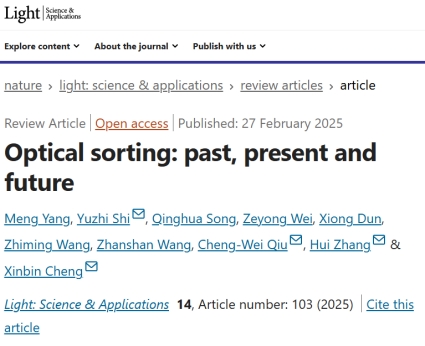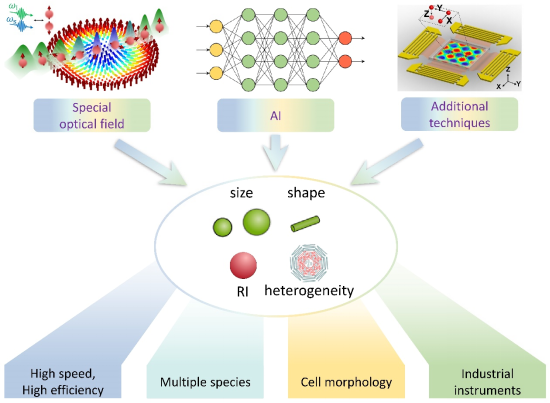Recently, Professor Yuzhi Shi and Professor Hui Zhang from the team of Professor Zhanshan Wang and Professor Xinbin Cheng at the School of Physics Science and Engineering, Tongji University, in collaboration with Professor Cheng-Wei Qiu from the National University of Singapore, have conducted an in-depth exploration and systematic review of the development trajectory, fundamental principles, and significant research advancements in various optical sorting technologies in recent years. They also explored the potential applications of novel optical effects in this field. The review article, titled "Optical sorting: past, present and future," has been published in Light: Science & Applications.

Particle sorting plays a crucial role in various fields such as chemical catalysis and drug delivery. The size and shape of nanoparticles significantly affect their performance, particularly in the case of chiral drugs, where toxicity is closely related to molecular structure. Optical sorting technology integrates optical forces (such as optical radiation pressure, optical gradient force, optical pulling force, and optical lateral force) with microfluidics, artificial intelligence (AI), imaging, and immunoassay techniques, significantly improving sorting efficiency and precision. The review categorizes optical sorting into active and passive methods (Figure 1) and provides a detailed analysis of their principles and future research directions, offering valuable insights for researchers.

Figure 1: Overview of optical sorting principles for micro/nano- particles
Active sorting techniques utilize movable optical tweezers combined with external signals (such as fluorescence, Raman signals, and machine learning data) to achieve precise control over particle motion. Passive sorting techniques, on the other hand, rely on the different response of particles to optical fields for automatic sorting. The article also explores the potential of metasurface technology, multipole effects, and topological optical effects in enhancing sorting accuracy, resolution, and selectivity.
Despite its widespread applications, optical sorting technology still faces challenges such as slow sorting speeds and difficulties in processing high-concentration samples. Future advancements may involve designing specialized optical fields, optimizing AI algorithms, and integrating auxiliary technologies to overcome these limitations, enabling faster and more efficient multi-species sorting and cell morphology studies (Figure 2). It is anticipated that more nanoscale precision optical sorting devices will emerge, widely deployed in research institutes and hospitals for rapid processing of drug molecules, viruses, exosomes, and other samples.

Figure 2: Schematic of the prospect of optical sorting.
Professor Yuzhi Shi from Tongji University, Professor Cheng-Wei Qiu from the National University of Singapore, Professor Hui Zhang from Tongji University, and Professor Xinbin Cheng are the corresponding authors of the paper. Meng Yang, a master student at Tongji University, and Professor Yuzhi Shi are the co-first authors. Other contributors include Professor Zhanshan Wang, Associate Professor Zeyong Wei, and Associate Professor Xiong Dun from Tongji University, Associate Professor Qinghua Song from Tsinghua University, and Professor Zhiming Wang from the University of Electronic Science and Technology of China.
Paper link: https://www.nature.com/articles/s41377-024-01734-5
